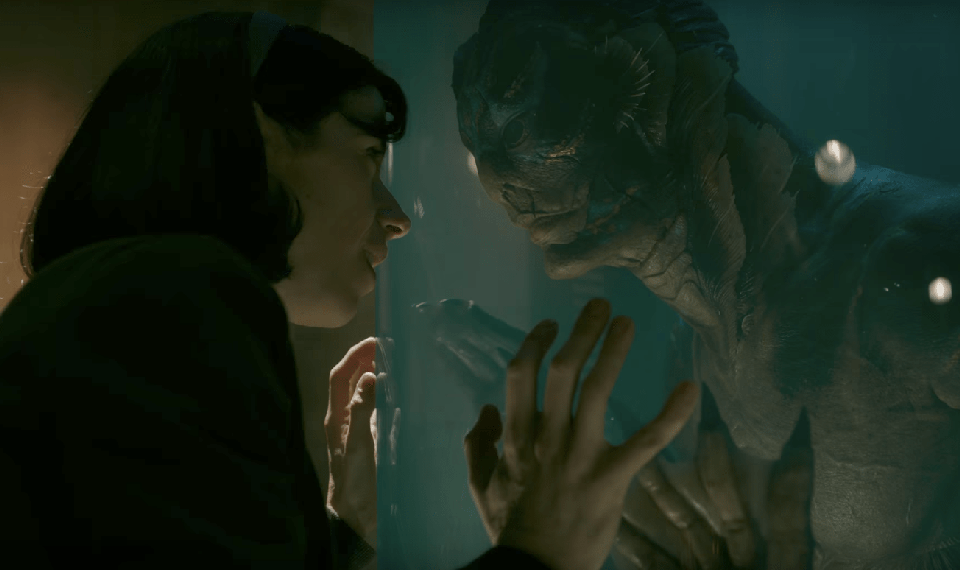
The Shape of Water is an epic romance from that most imaginative of filmmakers, writer-director Guillermo del Toro. The Shape of Water may become the most-remembered film of 2017.
The story is set in 1962 Baltimore. Elisa (Sally Hawkins) is a mute woman who lives in a dark apartment above an aging downtown movie palace. She and her friend Zelda (Octavia Spencer) work as a janitors on the graveyard shift at a government research laboratory. The Cold War adventurer Strickland (Michael Shannon), a tower of menace, has captured an amphibian creature from the Amazon and has brought him in chains to a tank at the laboratory. The male creature, in the approximate form of a human, has dual breathing systems, so he can survive both under water and on the surface; it develops that he also has intelligence, feelings and even healing powers.
The scientist Hoffstetler (Michael Stuhlbarg) wants to study Amphibian Man to discover how his species could benefit humanity. Strickland, on the other hand, wants to rush into killing and dissecting the creature. Strickland is a sadist, who enjoys brutalizing Amphibian Man with his cattle prod.
Elisa is repulsed by Strickland’s torture, and she feel compassion for Amphibian Man. She starts showing Amphibian Man some kindness. As Amphibian Man becomes more trusting of Elisa, he feels gratitude for her kindness. She cares about him, too, first with pity and then with the fondness of a pet owner. As Amphibian Man’s intelligence and feelings become more apparent, the two become more equal, and their mutual fondness blossoms into passion.
But Strickland’s nefarious plans force Elisa and her supporters into a race against the clock to save Amphibian Man. And so we’re off on a thriller, with a heist-like rescue and a chase, culminating in an ending of operatic scale.
Now this is a romance that transcends species. I totally bought into this. If you can’t, the movie is less moving and much, much more odd. Romance is often consummated sexually, and this one is, too.
Sally Hawkins is not conventionally pretty, yet del Toro didn’t make Elisa a stereotypical spinsterish ugly ducking. Elisa is vital, with a rich inner life, a wicked sense of humor and cultural interests, and who expresses herself sexually. She may only be a night janitor with a disability, but that doesn’t define her. Elisa’s defiant gaze at Strickland is one of the movie’s highlights.
Hawkins’ performance is a tour de force. Shannon makes for a formidable villain, especially when he clenches his own gangrenous fingers. Michael Stuhlbarg, Octavia Spencer and Nick Searcy (Art Mullen in Justified) are all excellent.
Richard Jenkins’s performance as Elisa’s neighbor Giles is very special. This is a very vulnerable man, with his sexuality trapped in a closet, his growing sensitivity to his own aging and his career as a commercial artist becoming obsolete. With his episodes of resolute denial spotted with instances of inner strength, both the character and the performance are very textured. And Giles’ eccentric reactions to the story are very, very funny.
I highly recommend Guillermo del Toro’s interview on NPR’s Fresh Air , in which he discusses many of his choices in developing the story of The Shape of Water, including shaping the character of Elisa and the inspirations from The Creature from the Black Lagoon. In the interview, del Toro explains that, if this movie were made in 1962, Strickland would have been the hero, the Cold Warrior protecting humans from the alien creature. Instead of course, the heroes of The Shape of Water are a woman with a disability, a woman of color, a gay man and a commie spy and, of course, a monster.
None of the characters have any reason to envision that white male supremacy, oppression of gays or the Cold War would end, or even be tempered, in their lifetimes. It’s a graphic time capsule, with the grand movie palace empty, pushing out a sword and sandal epic to compete in futility with the small screen offerings of Dobie Gillis, Mr. Ed and Bonanza. It’s a world in which the coolest thing imaginable is a teal 1962 Cadillac De Ville.
Here’s where Guillermo del Toro’s imagination triumphs. This story could not be told as well in a novel, on stage or in any other artistic medium. It has to be a movie.
This is filmmaking at its most essential and most glorious. Del Toro, along with production designer Paul B, Austerberry and art director Nigel Churcher, create a set of vivid and discrete worlds, each with its own palette. There are Elisa’s and Giles’ dark apartments, the brooding institutional green of the laboratory and the bright mid-century modern domain of Strickland’s family.
This is a beautiful movie. Between del Toro’s filmmaking genius and Hawkins’ performance, The Shape of Water is a Must See, one of the best movies of the year.
